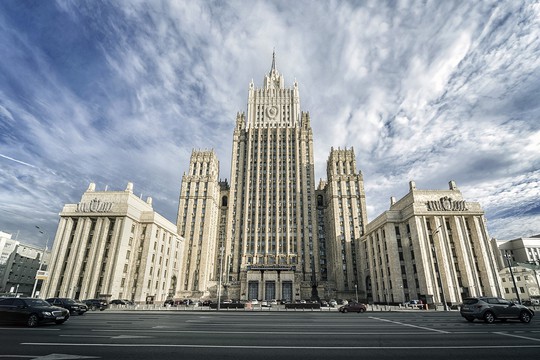Foreign Ministry statement concerning a moratorium on deploying ground-based intermediate- and shorter-range missiles.
After the United States has undertaken deliberate actions that led to termination of the Treaty on the Elimination of Intermediate-Range and Shorter-Range Missiles (INF Treaty) in 2019, the Russian Federation made proactive efforts to promote restraint in this particular area. These efforts were reflected in top-level statements made in 2019-2020, which included Russia voluntarily assuming unilateral self-restraint on deploying ground-based INF systems for as long as similar US-made missile weapons do not emerge in the corresponding regions of the world. Russia directly called upon NATO countries to declare a reciprocal moratorium on deploying weapons that had been earlier banned under the INF Treaty, and US allies in the Asia-Pacific region to support our efforts to prevent the arms race in that part of the world.
Regrettably, Russia’s initiatives were not reciprocated. The United States and its allies openly declared their plans to deploy US ground-based INF missiles across the regions and moved along significantly in their efforts to implement these plans. An increasing body of objective data indicates, in particular, that the current state of affairs is as follows: testing a wide range of baseline versions of these US-made weapons has mostly completed, or is in its final phases; serial production of some of these systems is underway; the Pentagon is forming and deploying specialised units and commands in the corresponding regions to enable their forward deployment and use; the requisite infrastructure is being developed to suit these purposes; and there is growing evidence of such missile systems being transferred to areas of military training activities jointly with allies outside the US territory.
Since 2023, we have observed instances of US systems capable of ground-launched INF strikes being transferred to the European NATO countries for trial use during exercises that clearly have an anti-Russia slant, such as exercises in Denmark which involved the use of a mobile Mk70 launcher.
In the Asia-Pacific, we note that under the pretext of exercises, a Typhon mid-range capability missile system was delivered to the Philippines in April 2024 and remains stationed there. The same system was used in Australia in July during live-fire exercises as part of the Talisman Sabre 2025 multilateral training. During those exercises, the US military carried out the first overseas deployment of the Dark Eagle intermediate-range hypersonic system, openly stating that this was done to “project power” and emphasising the system’s rapid redeployment capability.
Furthermore, during Talisman Sabre 2025 exercises, an Australian crew of the US-supplied HIMARS system launched a US-made PrSM missile, which had been tested by the Pentagon in 2021 at a range exceeding 500 km and qualifies as a ground-based INF-class missile. These missiles were launched by the US Army from the Republic of Palau in June 2024 using an advanced autonomous HIMARS-based platform.
Notably, these PrSM tests and PrSM missile firing exercises effectively mean that every M142 HIMARS and its tracked counterpart, the M270 MLRS, can be regarded as ground-based INF launchers. Future PrSM modifications are expected to exceed ranges of 1,000 km. These US-made systems have been widely deployed and continue to be deployed in many countries around the world, including US allies and partners, as well as Ukraine, which is using these systems in the warfare against the Russian Federation.
We are thus witnessing a growing number of facts indicating the emergence of US-made weapons in a variety of regions around the globe including the regions that are of particular national security importance for Russia whose specifications qualify them as ground-based intermediate- and shorter-range missile systems.
The above actions by the United States and its allies go hand-in-hand with the official statements to ensure the long-term (in fact, permanent) presence of such US weapons in Europe and the Asia-Pacific. For example, Washington and Berlin have announced plans to begin deploying Typhon and Dark Eagle systems in Germany starting in 2026 with the stated goal of their “long-term basing.” Moreover, a specialised US operational group in charge of these systems has been permanently stationed in Germany since 2021.
The plan stated by a number of US allies to acquire ground-based INF systems from Washington and/or develop their own missiles with ranges falling within the 500-5,500 km bracket, or to expand their existing national arsenals of such weapons constituted an important additional factor. Clearly, these weapons systems constitute extra forces and facilities that will be used during “integrated” operations that are planned jointly by US military and their allies as part of the corresponding alliances and coalitions.
The above steps by the collective West will form and build up destabilising missile capabilities in the regions that are adjacent to the Russian Federation, thus creating a direct and strategic threat to our country’s security. Overall, these dynamics have serious negative implications for regional and global stability and dangerously escalate tensions between nuclear powers.
Russia has consistently made it clear that this scenario will have our country take offsetting military-technical measures in order to neutralise emerging threats and to maintain strategic balance. Our repeated warnings on this account have been ignored, and the US-made ground-based INF systems are being deployed in Europe and the Asia-Pacific.
In this regard, the Russian Foreign Ministry states that the conditions for maintaining a unilateral moratorium on the deployment of similar systems have ceased to exist. We are authorised to declare that the Russian Federation no longer considers itself bound by the previously adopted self-imposed restrictions.
Decisions on the specific variables as they apply to response measures will be made by the leadership of the Russian Federation based on interagency analysis of the scope of deployment of the US-made and other Western ground-launched INF systems, as well as overall developments in international security and strategic stability.
read more in our Telegram-channel https://t.me/The_International_Affairs

 0:17 05.08.2025 •
0:17 05.08.2025 •























